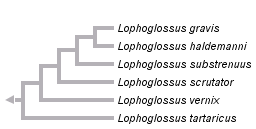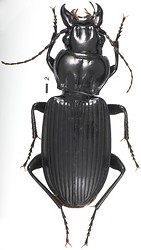Lophoglossus



This tree diagram shows the relationships between several groups of organisms.
The root of the current tree connects the organisms featured in this tree to their containing group and the rest of the Tree of Life. The basal branching point in the tree represents the ancestor of the other groups in the tree. This ancestor diversified over time into several descendent subgroups, which are represented as internal nodes and terminal taxa to the right.

You can click on the root to travel down the Tree of Life all the way to the root of all Life, and you can click on the names of descendent subgroups to travel up the Tree of Life all the way to individual species.
For more information on ToL tree formatting, please see Interpreting the Tree or Classification. To learn more about phylogenetic trees, please visit our Phylogenetic Biology pages.
close boxIntroduction
Lophoglossus includes six species restricted to North America. They share distinct autapomorphic characteristics in adult and larval stages. All the species are found in wet forest, swamps and swampy ground near rivers and streams. The genus was recently revised (Will 1999).
Species key to adults of Lophoglossus
1. Ventral sclerites of the meso and meta thorax punctate laterally...21'. Ventral sclerites of the meso and meta thorax impunctate)...7
2(1). Elytral microsculpture reticulate or granular, generally duller (same sex compared); male without subapical mesotibial spine, apical spine present...3
2'. Elytral microsculpture weak or obsolete, if present stretched, shinier (same sex compared);male with subapical mesotibial spine, apical spine small... L. scrutator (LeConte)
3(2). Pronotal hind angles obtusely rounded ... L. gravis LeConte
3'. Pronotal hind angles approximately right angled ...4
4(3'). Males,expanded protarsi ...5
4'. Females,protarsi simple...6
5(4). Metatibia with process over apical spur smaller, length less than 1.5 x width ... L. haldemanni (LeConte)
5'. Metatibia with process over apical spurs elongate, greater than 2 x width ... L. tartaricus (Say)
6(4').Elytral microsculpture granulate, dull; very large species 21 to 25mm) ... L. haldemanni (LeConte)
6'. Elytral microsculpture smooth, rather shiny, never granulate; smaller, 16 to 20mm ... L. tartaricus (Say)
7(1). Elytra with depressed area at the apexes of stria 3-5 ...8
7'. Elytra without depressed area at the apex, stria 3-5 uniformly convex, males with smallapical and large subapical mesotibial spines ... L. scrutator (LeConte)
8(7'). Outer basal impression of the pronotum sharply delimited against a convex area along the explanate laterally margin; hind trochanter usually with distinct euventral flattened area ... L. vernix Casey
8'. Outer basal impression of the pronotum without a sharp demarcation laterally, broadly flattened to the explanate lateral margin; hind trochanter usually cylindrical or with a small and poorly defined flat euventral area ... L. substrenuus (Csiki)
Discussion of Phylogenetic Relationships
Support for monophyly comes from two synapomorphies that are character states not known from any other pterostichine genus- presence of a lateral process on the median lobe of the aedeagus
- the prominent apophysis of the left paramere
Within the genus the following groups are supported
substrenuus-group (substrenuus , vernix)
- elyral tip with a depressed area near apex on striae 3-5
- the basal ensiform setae of gonocoxite II reduced or absent
(scrutator),((tartaricus)(haldemanni , gravis))
- mesotibia apical spine present
- last visible tergite distinctly thickened internally along apical margin
- left lateral sacculus of endophallus elongate
- meso and metathorax punctured ventrally
tartaricus-group ((tartaricus) (haldemanni , gravis))
- seta at hind angle of pronotum distant from the lateral margin
- loss of apical spine of mesotibia in males
- male abdomen with additional internal process
- tip of aedeagus dorsally hooked
- endophallus with sclerotized region at base of left lateral sacculus
- endophallus with well developed tricoid field
- elytral microsculpture isodiametric
- right paramere broad and blunt
(haldemanni , gravis)
- elytra dull due to granulate microsculpture
- male metatibial spine short
- right paramere wide
Title Illustrations

| Scientific Name | Lophoglossus haldemanni |
|---|---|
| Identified By | K.Will |
| Life Cycle Stage | Adult |
| Image Use |
 This media file is licensed under the Creative Commons Attribution License - Version 3.0. This media file is licensed under the Creative Commons Attribution License - Version 3.0.
|
| Copyright |
© Kipling Will

|
About This Page
Page copyright © 2005
All Rights Reserved.
- First online 07 July 2006
- Content changed 07 July 2006
Citing this page:
Tree of Life Web Project. 2006. Lophoglossus. Version 07 July 2006 (temporary). http://tolweb.org/Lophoglossus/51633/2006.07.07 in The Tree of Life Web Project, http://tolweb.org/







 Go to quick links
Go to quick search
Go to navigation for this section of the ToL site
Go to detailed links for the ToL site
Go to quick links
Go to quick search
Go to navigation for this section of the ToL site
Go to detailed links for the ToL site